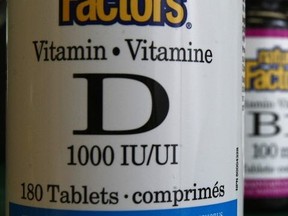
Vitamin D was a hot topic at the height of the pandemic when Covid-19 patients often proved to be deficient in the vitamin.
Recent studies show a relationship between vitamin D deficiency and COVID-19 severity and mortality.
From our newsroom to your inbox at noon, the latest headlines, stories, opinion and photos from the Toronto Sun.
Thanks for signing up!
A welcome email is on its way. If you don't see it, please check your junk folder.
The next issue of Your Midday Sun will soon be in your inbox.
Vitamin D is crucial for strong bones, heart and brain health and a robust immune system.
A raft of researchers can show you proof that Vitamin D is like a superpower for the prevention of heart disease and cancer, and what’s more, it combats depression and boosts mental acuity.
Just as many researchers can show you proof that it doesn’t really do any of those things.
The debate about Vitamin D supplements goes on, although seniors, breastfeeding mothers and people with certain medical conditions, such as kidney disease, often take supplements as they are at risk of Vitamin D deficiency.
For anyone living north of the 37th parallel — Canadians, for example — Vitamin D supplementation is important.
Most of us get Vitamin D from the sun during the summer.
In a Canadian winter, however, the sun’s UVB rays are weak and can’t do the job.
Dr. Antony Young, an emeritus professor of experimental photobiology at the St. John’s Institute of Dermatology at King’s College London, told the New York Times: “For all practical purposes, one cannot make vitamin D in cold climates in winter.
Recommended video
“Winter sunlight does not have enough of the UVB component that is essential for vitamin D synthesis.”
Young said fair-skinned people can produce enough vitamin D in summer by exposing their faces, arms and legs to the midday sun for five to 10 minutes (without sunblock).
How much you need depends upon age, skin tone (more sun is needed for darker skin) and general health.
The Canadian government guidelines for vitamin D suggest 400 International Units (IU) for infants, 600 IU daily for children (over a year old) and adults, and 800 IU daily for people over 70.
The upper limit, which is where many doctors and nutritionists will point you, is 1000 IU daily for infants, moving slowly upward to 4000 IU for anyone aged 9 and older.
The La Leche League — an international organization supporting breastfeeding — has information on Vitamin D supplementation and noted that a breastfed baby should have between 400 to 800 IU daily of Vitamin D3 supplements.
Vitamin D toxicity caused by supplements is extremely rare, and usually requires massive doses of the vitamin over many months.
According to Dr. Mark Tarnopolsky, of StayAbove Nutrition, the benefits of Vitamin D cannot be overstated.
Calling Vitamin D a “critical factor” in the maintenance of good health, Tarnopolsky said in a statement that a high proportion of Canadians have deficient or insufficient levels.
“Current research shows that Vitamin D deficiency can lead to a host of secondary health complications, including a weakened immune system.”
Vitamin D supplements are a cost-effective option to combat Vitamin D deficiency, he added, “supporting a strong and healthy immune system, which in turn helps protect against viral infections, such as COVID 19.”
Vitamin D3 supplements are the right choice (vs. D2), and drops are more readily absorbed by the body than pills.
You can also get Vitamin D from some foods, such as salmon, tuna, sardines and other fatty fish, egg yolks, beef liver, cod liver oil — a staple of many a baby boomer childhood — and from foods fortified with vitamin D, such as milk and some cereals.


